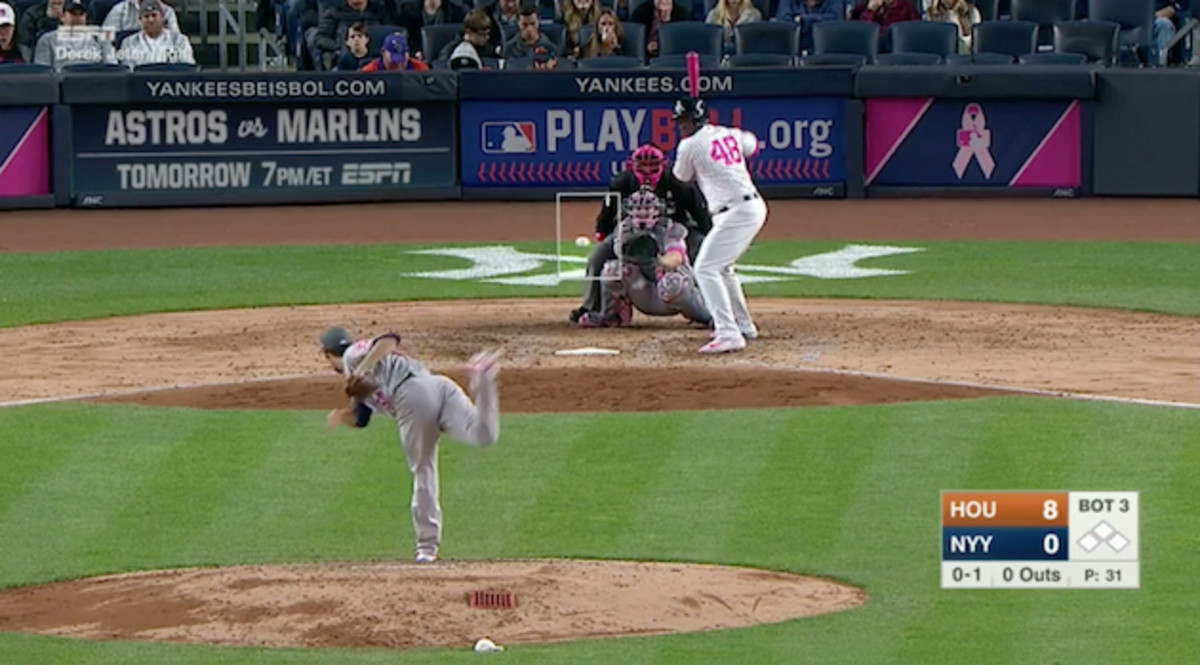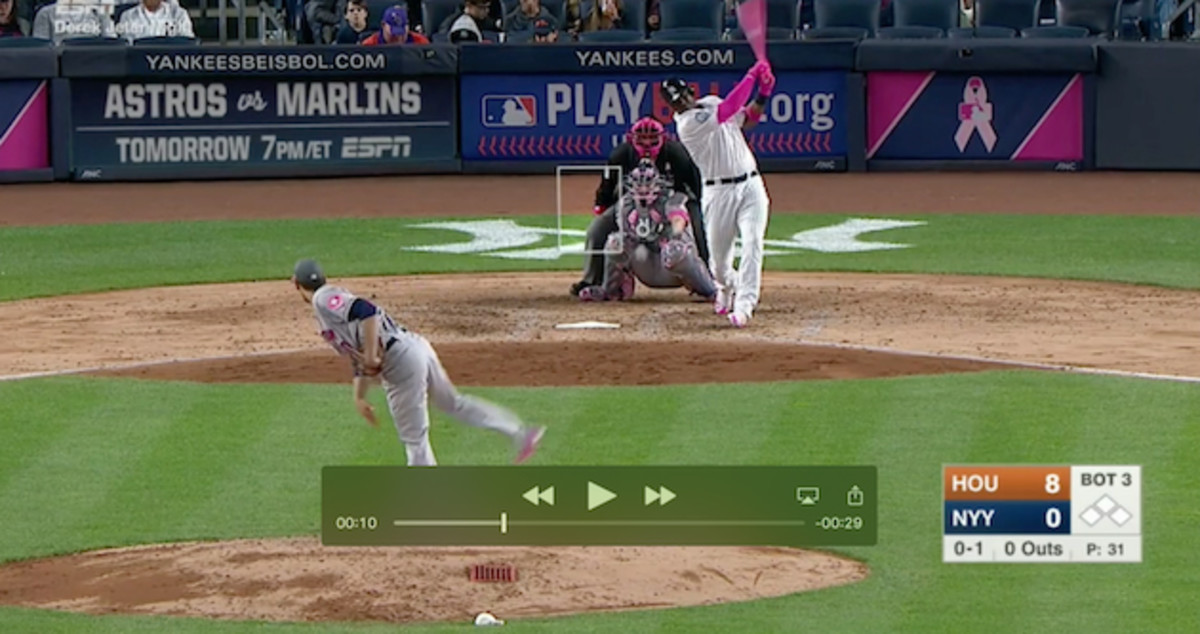Charlie Morton's comeback, led by his curveball, is helping fuel the Astros

Houston is at the center of the baseball universe this season. The Astros are 26–12 and, according to Fangraphs, already own a 92.5% chance of winning the AL West. Carlos Correa shook off a slow start to the season, and looks like an MVP candidate at 22 years old. George Springer has nine homers and a .261/.340/.507 slash line. Jose Altuve started slowly as well, but is back in a groove, and has his batting line up to .286/.357/.436. Josh Reddick, Evan Gattis and Brian McCann are all delivering beyond expectations. Meanwhile, the staff, led by Dallas Keuchel and Lance McCullers has been excellent. The Astros rank third in the majors in ERA, seventh in FIP and seventh in fWAR.
All of that team and individual success has kept one player off the radar. Charlie Morton has made eight starts this year, totaling a 3.97 ERA, 3.30 FIP, 1.37 WHIP and, most impressively, 54 strikeouts in 45 1/3 innings. Morton has never even hinted at this sort of strikeout ability in the past. His previous career best strikeout rate and K/9 came with the Pirates in 2014, when he fanned 18.9% of the batters he faced and posted 7.2 K/9. Neither of those suggests a strikeout artist in the making, but that is exactly what Morton has become this season.
Morton has suffered a number of significant injuries during his career, all of which stunted his growth. He needed surgery to repair a torn labrum in his hip after the 2011 season. In June of 2012, he underwent Tommy John surgery, which kept him out for a full year. He had to go under the knife again for his surgically repaired hip in 2014, and the rehab from that second surgery dragged into the summer of 2015. Last year, he suffered a season-ending torn hamstring in April. Now as healthy as he can possibly be, a couple of features of his arsenal stand out when you go under the hood.
MLB Mock Draft 1.0: Should Twins take Brendan McKay or Hunter Greene with No. 1 pick?
First, Morton is throwing harder than ever this season. His sinker, which is his primary fastball, sat in the low-90s for his entire career. Last year, it shot all the way up to an average velocity of 94.8 mph before his hamstring injury. This year, his average sinker velocity is 96.1 mph. Life is a whole lot different when you throw 96 compared with 92, as Morton did for most of his time with the Braves and Pirates early in his career.
Second, Morton is relying on just two pitches to carry him through most starts. While he still throws a four-seam fastball, cutter and splitter, his sinker and curveball have a combined usage rate of 72.2% this season, according to Statcast. The focus on those two pitches, coupled with Morton’s velocity spike, has resulted in a pitcher finding another level of performance.
Morton’s sinker is at the center of everything he does, but, even at 96 mph, it’s just a sinker. It’s going to get knocked around when it catches too much of the zone, and won’t get many whiffs. Hitters will square it up when Morton uses it in predictable counts. He can’t succeed without it, but it’s not going to have gaudy numbers. It’s a utilitarian pitch, and it does its job quite well.
The curveball, however, is a thing of beauty.
In most rotations, Morton would own the best curveball. That will never be the case for him, so long as he shares a rotation with McCullers. Still, don’t let that sour you on the glory of Morton’s deuce. It’s a filthy out pitch, even when hitters manage to make contact.
Paul Goldschmidt is on his way to a potentially historic season
Morton has thrown 199 curveballs this year. Nearly one-quarter of those, 48, have produced whiffs. Another 28 have been called strikes, while hitters have fouled off 19. They’ve put 24 of Morton’s curveballs in play, with eight going for hits. Of those eight, six have been singles, one was a double and one was a homer, off the bat of Jean Segura. It would better fit the narrative if all eight were singles, but that’s a ratio with which any pitcher can live. If a pitcher can get a whiff or an out with a pitch more than 70% of the time you throw it, that’s an offering he is going to trust with good reason.
Morton has two double-digit strikeout games this season, both of which came within his last four trips to the mound. On April 28, he struck out 12 A’s in seven innings while picking up his second win of the season. Last weekend, he fanned 10 Yankees in 5 2/3 innings to move to 5–2 on the year. Half of those 22 strikeouts came with the curveball on strike three. Let’s take a look at a few of them.
While Morton’s breaking pitch is a curveball, he sometimes throws it with a bit more tilt that makes it resemble a slider. It’s always technically a curve, but it gives hitters a different look, and the way it darts down and in on lefties can make it especially effective. That’s something Stephen Vogt learned late last month.
The curve to Vogt started over the plate, and ended up outside the zone both low and inside. This one to Yonder Alonso starts a bit off the plate outside, and travels back over the plate into the zone. Alonso isn’t necessarily fooled by the pitch, but the movement is still too much for him.
Morton’s ability to use the curve to both sides of the plate is one reason why it’s such a strong weapon. Another is the differing looks we just discussed. Here’s the 12-to-6 version of Morton’s curveball, which he used to get strike three against Aaron Hicks last weekend.
The breaking balls to Vogt and Alsono, as well as the one to Hicks, all get coded as curveballs, but ask hitters if they’re really the same pitch. That’s just another layer for them to have to think about when they step into the box against Morton.
Finally, let’s take a look at a wonderful bit of sequencing. Morton struck out seven consecutive batters from the first to the third innings against the Yankees. The seventh was Chris Carter. Now, to be fair, striking out Carter isn’t necessarily the greatest achievement for a pitcher. The guy swings and misses a lot. It’s not the strikeout itself, however, that’s impressive. It’s the way Morton set Carter up to be absolutely helpless against the curve.
On an 0–1 pitch, Morton went to his bread and butter, the sinker. The pitch starts out as a strike, but it tails sharply in on Carter’s hands and ends up off the plate inside. He fouls it off at the plate to fall into an 0–2 hole.
That’s a filthy pitch for any hitter, especially a righty, to deal with. Look at where the pitch was when Carter committed to swing, and then where it ended up once it actually traveled into the hitting zone.


Seriously, there’s no handling that pitch. The only way is to identify its spin and location, and trust that it is going to end up out of the zone. That’s much easier said than done.
After a purpose curveball low and away ran the count to 1–2, Morton doubled up with his out-pitch. This time, though, it wasn’t a chase offering, but in the zone. We’ll take a look at this one before breaking it down.
You can tell by Carter’s late swing that he was guessing sinker. He was, as we just said, trusting that it was going to end up off the plate inside. By time he realizes it’s a curveball and not a sinker, it’s too late, and he flails through it for strike three. You see? Much easier said than done.
Morton isn’t Keuchel and he isn’t McCullers. He’s not going to induce as much soft contact as the former, and he won’t miss as many bats as the latter. The good news for both the Astros and his fantasy owners is that he doesn’t need to be. He’s a worthy No. 3 in real life, and his strikeout ability makes him a fantasy asset in all formats.
